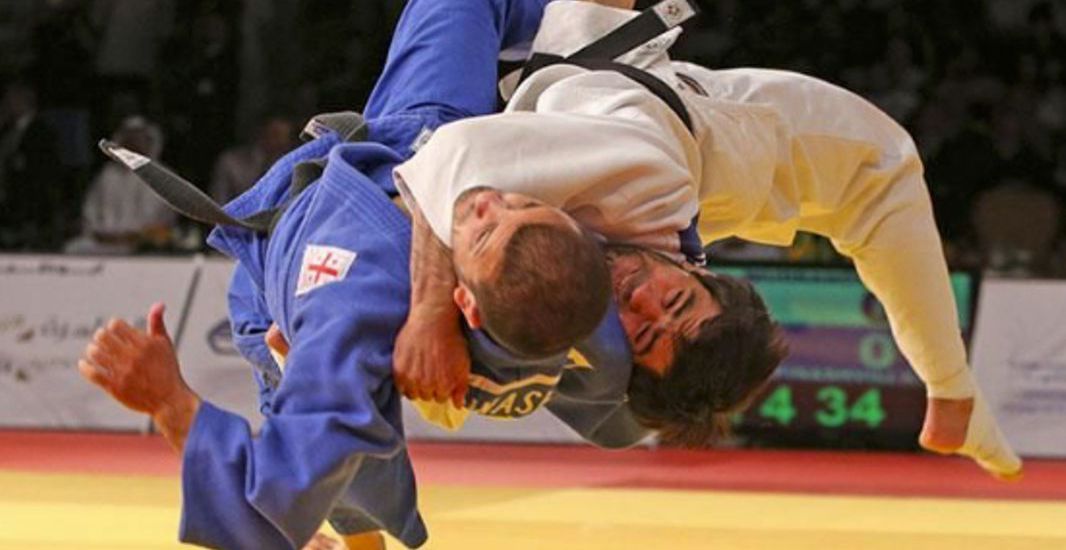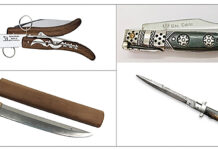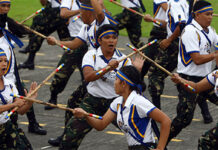The Force of Competitive Throws
The Impact of someone being thrown on their head on concrete is far more devastating than the damage resulting from any punch or kick.
The formula:
F = 2*W*h/d
F = the impact force in units of pounds force (lbf)
W = the weight of the falling object (lbf)
h = the falling height in units of inches (in)
d = the deformation distance of the falling object (in)
For example, if a 200 lbf person is thrown on their head from a height of four feet, and we assume the drop is straight, (and the neck doesn’t bend) we have the following information:
W = 200 lbf
h = 4 ft (48 in)
d = 1 in
The resulting impact force is 2*(200)*(48)/(1) = 19,200 lbf
If that force is applied over a 9” sq. section of a person’s head, you create a pressure, or a stress of 2,133 pounds per square inch. In general it takes about 520 lbf to crush a human skull. A four foot drop onto someone’s head landing on concrete can potentially induce a concussion, coma or death. If the neck collapses it can potentially cause paralysis or death.
The Jujitsu Lineage – Comparing the Three Styles
It’s important to differentiate the fighting styles that emerged from Japanese jujitsu. There is a great deal of confusion between Japanese jujitsu (the original style), judo and BJJ (Brazilian Jujitsu), even by many senior students in each of the disciplines. Essentially jujitsu, judo and BJJ all share a common denominator: Defeating a larger and stronger opponent with technique.
Jujitsu
Jujitsu was originally developed in Japan during the mid-16th century and eventually grew to more than 700 schools, with each school emphasizing a particular approach or specialization. Two of these schools formed a major basis of Kano’s judo.
Jujitsu Workouts
A workout in jujitsu is not nearly as vigorous as one in judo or BJJ. Tactics are usually practiced with partners employing drills – randori is limited due to the dangerous nature of some techniques.
Judo
Judo refers to the amalgam of several jujitsu styles that Kano created in 1882. There is a heavy emphasis on throwing, but groundwork is also a factor. Kano borrowed techniques from several jujitsu styles and eliminated dangerous techniques so people could safety practice it as a sport. Since the 1964 Olympics in Japan, Judo has become an Olympic sport and is practiced all over the world.
Judo Workouts
The workout is extreme and taxes the whole body. I used to wake up in the morning with my fingers frozen in a claw configuration just from grabbing the gi so hard from the previous evenings training. There are also more than a few injuries, even for skilled judoka’s, accidents happen in the rough and tumble world of judo.
BJJ (Brazilian Jujitsu)
Bjj was developed from old style judo/jujitsu. In the early days, judo was called Kano’s jujitsu. BJJ is essentially grappling with a focus on groundwork. It was brought to Brazil from Japan by Mitsuyo Maeda. He introduced judo and jujitsu to Carlos Gracie in 1925. Besides teaching Kano’s jujitsu, he also the taught leg locks of Kosen judo as well as elements from catch-as-can.
BJJ has become one of the most popular martial sports in the world. The goal is to take the opponent to the ground and control, pin, armlock or choke him/her. It’s an integral part of MMA.
BJJ Workouts
Like judo, BJJ is extremely taxing on the body, it’s a super-tough workout. Some elements of catch wrestling are taught in a number of schools along with leg-locks
______________________________________________
Regarding Groundwork (Ne-Waza)
I was never a fan of groundwork in judo, it was always such grueling work, and I was lazy, however I have to admit, to be well rounded it’s a necessary skill that everyone needs, particularly for getting off the ground.
Japanese Jujitsu teaches groundwork, the details depend on the particular style. I found BJJ groundwork more sophisticated than mainstream judo’s ne-waza. Kosen Judo (a variation of Kodokan judo) also incorporates a more intensive level of groundwork including leg locks.
Despite what many BJJ people say (that every fight goes to the ground). I have experienced it only once. IMO, If you have a good standing clinch going to the ground is less likely. However, as always you need to be prepared for the worst.
In regards to self-defense, the ground is the last place you want to be – WHY – because: 1. Debris on the ground such as: glass, stones and metal can injure you (I have met several people who have experienced this). 2. you are vulnerable for attack from the side or rear, from the attacker’s allies, or 3. the attacker may have an edged weapon and stab you.
______________________________________________
Psychology For the Street
Judo throws can cause serious and extensive destructive damage, so why am I advocating judo for an integrated self-defense program — Because the judo tactics I teach are heavily altered and adapted for the street. The goal is 1) not to seriously injure your attacker, it can cause serious legal problems for you, 2) adapt the throws so beginners can easily learn and apply them.
– Chokes & Joint-Locks
Whereas judo, jujitsu and BJJ use submissions for chokes and joint locks. The street defender must not disengage if the attacker taps out. Instead the defender should take the choke or joint-lock to conclusion – that is to render the attacker unconscious and/or break the joint.
One of my former students used a arm-bar on an attacker – the attacker tapped out, the student let go and was knocked down. He was fortunate that the attacker didn’t have a weapon.
Note: Once you have choked out your attacker, lay him on the ground carefully so not cause extreme injuries to his head while falling (the worst head/neck injuries occur when the attacker hits his head on a hard surface). In addition never turn your back on someone you’ve choked out. Some individuals wake up almost immediately, while others take a few minutes. In all cases the opponent will wake still thinking he is in the middle of a fight and keep attacking you.
For the average judo player my modifications may not follow the traditional look and feel of the classic throws, however they echo the same concepts. The Alterations are Important Because:
- Seriously injuring an attacker can lead to legal issues
- Some throws will propel you onto your attacker
- Throws should be easy to learn and apply
I don’t encourage students to learn all the throws listed here but to be familiar with them. Then carefully choose a few that might correspond to their particular talents, skills and constraints. Everyone has physical capabilities and limitations and the throws need to be adjusted to the individual.
Judo Techniques Broken Down
I usually ask students to select one throw for a large heavy opponent and one for a smaller lighter opponent. I have listed judo techniques that are applicable for the street from 5 major categories.
For example some throws are better suited for larger men/women, e.g. Harai-Goshi and Osoto-Gari. Seio-nage is better suited for smaller defenders. Sweeps are arguably best for very large opponents, however they are among the most difficult to master.
______________________________________________
Ashi-Waza (Sweeping, Reaping, Hooking Throws)
Kosoto Gake (Small Outside Hook)
Kouchi Gari (Minor Inner Reap)
Ouchi Gari (Major Inner Reap)
Osoto Gaeshi (Osoto Gari Reversal)
Osoto Otoshi (Large Outer Drop)
Deashi Harai (Forward Foot Sweep)
Te-Waza (Hand Techniques)
Tai-Otoshi (Body Drop – All Variations)
Seionage (All Variations)
Moroto Gari (Double Leg Takedown)
Sukui Nage (Side Scooping Throw)
Kibisu Gaeshi (Heel Trip Reversal)
Koshi-Waza (Hip Throws)
Harai Goshi (Sweeping Hip Throw)
Koshi Garuma (Hip Wheel)
Uki Goshi (Floating Hip)
Daki-Age (Double-Leg Pickup to Ground Slam)
Shime-Waza (Chokes)
Nami Juni Jime (Cross Choke)
Hadaka Jime (Rear Naked Choke)
Kata Ha Jime (Single Wing Lapel Choke)
Sankaku Jime (Triangle Choke)
Additional Chokes
Standing Lapel Scissor (Hasami) Choke
Standing Lapel Constrictor (Boa) Choke
Guillotine Chokes (Blood and Airway Variations)
Kansetsu-Waza (Joint Locks)
Note: In general, armlocks and wrist locks are difficult to apply immediately. In many cases the opponent needs to be softened up first with some strikes
Ude Hishige Waki-Gatame (outlawed in judo)
Ude Gatame (Standing Arm Lock)
The Mirror Hand – (Kagami) Counter to Wrist Grab
Adding Wrestling to the Mix
In addition to these modified throws, I also utilize and combine wresting moves with judo techniques including: arm-drags, two-on-ones, collar-ties and single/double leg takedowns, etc. However, these techniques Have also been altered for a standing clinch presentation. The advantage of wrestling takedowns is that they are generally easy to learn. In case of failing to throw an attacker, single-and double-leg takedowns can become a quick and effective followup.
______________________________________________
Street Judo – Tactics that Provide Advantages
- Playing Lefty – (i.e., throwing to the right) Playing lefty is the equivalent to a southpaw in boxing. When I started judo as an adult I used to get thrown so much I resembled a mop. After I switched to playing righty, even highly skilled judoka had a challenging time throwing me.
- Kuzushi is King The best throws occur with Kuzushi. In the movies the defender just goes in and magically throws the opponent, however it never happens that way. Teaching independent drills using kuzushi is important and not well understood by too many non-grapplers.
- Tsukuri Invariably I always find that many beginners often miss one of the most important points in throwing someone, that is Tsukuri (entering in). Most students don’t use the correct footwork when entering, they often position themselves too far away from their opponent. Without proper Tsukuri the throw will fail. The best way to correct this is to teach and monitor correct Uchi-Komi drills.
- Include Uchi-Komi in your Training Uchi-Komi (means fitting-in) it consists of drills that only approximate the first two parts of a throw, i.e. Kuzushi (unbalancing) and the entry (Tsukuri). This is done repeatedly with many partners. This is a great exercise for beginners and those without throwing experience, especially with older or out of shape students.
- Static & Dynamic Drills To gain functional experience with judo throws it’s important to take the throw to completion. Throws can be taught statically at first (to learn the technique), then slowly throwing the uke, then dynamically – throwing while the partner is moving.
- Learn How to fall on a hard Surface Slapping out to break the impact of the fall on a mat is one thing, however slapping out on the sidewalk is quite another. Teach your students to gently roll down and protecting their head.
- Hip Throws, Leg Hooks & Takedowns In general, as you develop your skills: something to keep in mind: whenever an opponent stands with their legs apart, go after their legs with hooks, sweeps and reaps (e.g. Ouchi / Kouchi etc.) or leg takedowns. When the opponent’s legs are close together, go in for hip throws.
- Stepping on the Opponents foot This is a great diversionary tactic for a throw, the attackers attention will be focused on his foot while you can set up the throw, but, you will need to learn standing clinch tactics to do this. When practicing with an Uke in class it’s important to ask your partner permission first in case he has foot injuries.
- Kicking the Attackers Ankle I’ve seen this in several competitions. One of the players walks onto the mat wrapped with a heavily bandaged ankle. His opponent takes advantage of this and selectively sweeps (actually kicks with his arch) the injured ankle multiple times and the injured player bows out. This also works well on the street. Kick the attacker on the inside of his ankle – it’s more delicate.
______________________________________________
Best Chokes for the Street
I prefer the following chokes for the street because they are easy to learn, easy to apply and scare the shit out of the victims. Inasmuch as the rear-naked is popular, it takes more time to apply. Best Chokes:
- Guillotine Chokes
- Lapel Chokes
- The Sleeper
______________________________________________
Joint-Locks for the Street
Joint locks look very easy to do in the movies however they are actually very difficult to do in reality. The best method is to soften up your opponent with some strikes first. In general I have seen a decline in the quality of joint locks overall, it could be because the emphasis these days are on techniques used in MMA. Joint locks can be extremely effective if done correctly.
______________________________________________
Throws to Avoid for the Street
As I previously mentioned, for the street you want to avoid the high value throws so popular in judo competitions. They are too ballistic and there is a chance that you will be jettisoned down to the ground with your throw. They can also seriously injure your attacker.
- Tomoe-nage Inasmuch as this throw launched my interest in judo, I do have some reservations about using it on the street especially by students with limited experience. It looks dynamic in the movies but the disadvantage is because of the low entry point, it often won’t do much damage unless you have mastered it. Another disadvantage is that you are quickly placing your back on the ground which may have debris such as glass, metal, nails etc. I have seen Tomoe-nage being used in public in real fights in Taipei, Hong Kong and Tokyo (in clubs), and in all cases the victim came back up right away. The reason it’s so popular in competition is because the victim falls on his back, giving the full-point (Ippon) to the thrower. It can however be a very effective throw for an advanced player.
- Osoto-Gari Osoto-Gari is a powerful throw and most martial artists in many martial styles are familiar with it. The counter for it is the exact same mirror-reversal throw. Unless you apply the proper kuzushi it can easily be countered by your opponent. Osoto-Gari done well can easily cause extreme injuries to the attacker. I prefer using an easier highvalue throw – a modified Kosoto-Gake.
- O-Goshi This is usually the first throw most beginning students learn, however I found it works best for thin flexible individuals, the throw is easy to avoid by slipping past and around the throwers hip, that’s why Kano developed Harai-goshi, so that the throwers out-stretched leg (sweep) will prevent the uke from slipping around.
- Drop knee Seio-nage (or any drop on-knees throw) This is quite popular in competitive judo however there is a huge difference when dropping to your knees on a Mat vs. a concrete sidewalk.
Makokomi’s and Other Sacrifice Throws
Kani Basami, Uki-Waza and Makikomi’s or similar throws that are based on you going to the ground with your opponent are risky. Your attacker might have advanced ground skills, or have a knife.
______________________________________________
Chokes to Avoid for the Street
- The Rear Naked
Inasmuch this choke is the main choke used in MMA, and popularized in the movies and TV. It works best when used on the ground – while sitting behind your attacker with hooks. When standing, it’s best to apply this choke to someone who is a head shorter. The reason I don’t like it for novices is because there are better chokes available which can be applied faster and easier, e.g. the sleeper.
______________________________________________
Groundwork For Self-Defense
Being able to escape from holds, pins and being punched on the ground is the chief concern for street judo. Nullifying a ground attack and getting back to your feet as fast as possible I feel are the most important aspects of ground fighting. There are non-traditional alternatives for fighting from the ground that include attacking the eyes, and drawing your weapon (the weapon you should always carry).
______________________________________________
High Value Judo Techniques for the Street
I usually teach the following judo (and non-judo) tactics first. Beginners need an easy array of techniques they can quickly learn and apply to gain confidence. These techniques are highly effective.
Throws
- Kosoto Gake Playing lefty, with a collar tie, and instead of sweeping the opponents left leg, I get close and wrap my leg high and slide down causing the opponent to fall down.
- Osoto Gaeshi This is the Osoto Gari reversal, as the opponent tries to apply the throw, lean forward and mirror the throw on him/her. Many martial arts styles are familiar with this throw, it’s important to know the counter.
- Taiotoshi This is technically a hand throw with a blocking leg. I like to teach the [double-foot-stop] version to beginners.
- Wrestling Takedowns (single and double leg) Judo has leg-takedowns of its own e.g. Moroto Gari, but I prefer the wrestling style takedowns. The leg(s) can easily be grabbed from any position. These are great for following up on a missed throw.
Chokes
- Guillotine Chokes
- Standing Lapel Scissors (Hasami)
- Standing Lapel Constrictor (Boa)
- Standing Okuri-Eri-Jime (sliding lapel- w/back control) Finish behind the neck or pulling same side lapel
Joint-Locks / Arm-Bars
- Waki Gatame Some variations of this technique are illegal in judo. It takes more time to master but it’s an excellent method of getting an arm-bar from a person grabbing you from the same-side or cross-side. Even if the opponents elbow faces downward, you can follow up with a single leg takedown.
- Ude Gatame (Standing) This is an easy technique to apply once your opponent straightens out his arm, with his elbow facing up, place his wrist on your shoulder and lower your level.
- Mirror Hand (Kagami) an excellent counter from single wrist-grabs
______________________________________________
*Why it’s important to learn the original Japanese names for judo techniques: Judo is played in most countries around the world, knowing the names of judo techniques is a language that helps you to communicate, compare and learn.
______________________________________________
Links:
Defense Science teaches a reality based program that teaches modified judo techniques to: Civilians, martial art schools, military personnel, sport fighters and LE Contact Info: director@defensescience.com
History of Jujitsu as a Method of Self Defense






